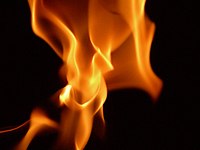
Photo from wikipedia
Abstract In this paper, Schlieren photography is used to ascertain the laminar flame speed of landfill gas (LFG) mixture. The flame is generated by utilizing a spherical constant-volume combustion chamber.… Click to show full abstract
Abstract In this paper, Schlieren photography is used to ascertain the laminar flame speed of landfill gas (LFG) mixture. The flame is generated by utilizing a spherical constant-volume combustion chamber. Besides, CHEMKIN package is used to numerically investigate the freely propagating flame. Three compositions of LFG named LFG30 (30% C O 2 + 70% C H 4 by volume) LFG40 (40% C O 2 + 60% C H 4 by volume), and LFG50 (50% C O 2 + 50% C H 4 by volume) are used to do experiments. The experimental and computational methods are validated by using valid reported experimental data. The effect of equivalence ratio from lean flammability limit to rich flammability limit, LFG composition, and pressure from 1 bar to 7 bar on laminar flame speed, adiabatic flame temperature, Lewis number, and flame thickness is examined. It is demonstrated that, laminar flame speed and flammability limit decrease with C O 2 dilution. Also, laminar flame speed and flame thickness decrease with reactants pressure, while the flammability limit enhances with the pressure. The results also show that the lean flammability limit does not take effect from pressure so much, although rich flammability is highly reliant on pressure.
Journal Title: International Journal of Hydrogen Energy
Year Published: 2020
Link to full text (if available)
Share on Social Media: Sign Up to like & get
recommendations!